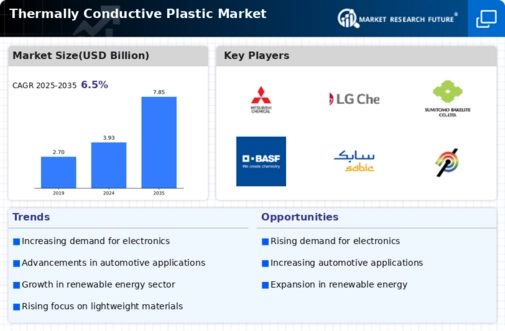The Thermally Conductive Plastic Market is characterized by a dynamic landscape where various players are actively vying for market share by leveraging innovative technologies and strategic collaborations. The increasing demand for lightweight and high-performance materials across diverse applications, including electronics, automotive, and consumer goods, has intensified competition among manufacturers. The growing need for enhanced thermal management solutions in consumer electronics and the automotive sector is driving innovation in thermally conductive plastics, leading to advancements in product formulation and applications.
Companies are focusing on developing a range of products that combine high thermal conductivity with other desirable properties such as electrical insulation, chemical resistance, and lightweight characteristics. This competitive environment is further propelled by the growing trend toward sustainability and the need for eco-friendly materials, encouraging firms to explore bio-based thermally conductive plastics.3M is a prominent player in the Thermally Conductive Plastic Market, recognized for its advanced materials and innovative manufacturing processes.
The company boasts a strong portfolio of thermally conductive adhesives, coatings, and engineered plastics that cater to diverse applications requiring effective thermal management. 3M's strengths lie in its extensive research and development capabilities, allowing for continuous innovation and the introduction of high-performance products.
Additionally, the company has a robust supply chain and distribution network, ensuring effective delivery of its products to customers across different regions. 3M's reputation for quality and reliability enables it to establish long-lasting relationships with clients in various industries, further solidifying its market presence as a trusted provider of thermally conductive solutions.Mitsubishi Chemical plays a significant role in the Thermally Conductive Plastic Market, focusing on delivering high-quality materials that meet stringent performance requirements. The company has made substantial investments in technology and innovation, developing a range of thermally conductive plastics designed for applications in the electronics and automotive sectors.
Mitsubishi Chemical's strengths include its ability to produce custom solutions tailored to the specific needs of customers, leveraging its advanced manufacturing techniques and extensive expertise. The company is committed to sustainability and has implemented eco-friendly practices in its production processes, which appeal to environmentally conscious consumers. With a strong commitment to quality and performance, Mitsubishi Chemical continues to enhance its product offerings, maintaining a strong competitive edge in the thermally conductive plastics space.












